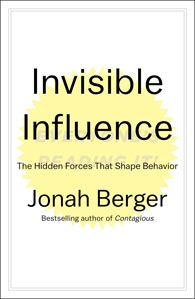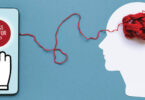It’s easy to see how social influence sways the buying habits and lifestyle choices of others. So why are we blind to its impact on our own lives?
Reviewed by Allan Fallow

Everyone loves a backstage glimpse of the drama of human behavior, and that’s just what Wharton School marketing professor Jonah Berger sets out to deliver in his second book, Invisible Influence. He takes a two-pronged approach: First, by laying out myriad real-world case studies, he invites us to learn about some of the “simple, subtle, and often surprising ways that others affect our behavior.” Second—and this is the ironic twist that rivets Berger throughout—he considers why it’s so easy to divine the forces that motivate others, but so ridiculously difficult to discern them in ourselves.
As he did in his earlier Contagious: Why Things Catch On (2013), Berger gets granular with his research: He conducted one survey by biking around Palo Alto, California, looking for BMWs. Every time he located a Beemer, the author relates, “I reached into my messenger bag, pulled out a piece of paper, and gingerly tucked it under one of the windshield wipers.”
But Berger’s fliers—more than 100 in all—were not coupons for car detailers or body shops. Instead, they were self-addressed, stamped surveys designed to ferret out the real reasons why BMW owners seem happy to spend ungodly sums of money on an asset that starts depreciating the instant you push its “Start” button. In addition to posing obvious questions about the buyers’ rationale—sales price, gas mileage, vehicle reliability—Berger asked them to identify which social forces might have come into play: How much, for example, did their friends’ opinions affect their purchase decision? What weight did buyers assign to the reputation of people associated with the brand?
These must have been dedicated respondents, for Berger didn’t stop there. He also asked each participant how much they thought all the factors swayed someone else’s BMW purchase. The replies demonstrated that the luxury-car owners easily perceived what an outsize impact social influence has on the vehicles other people buy. “But when it came time to turn that microscope on their own BMW purchase,” Berger writes, “Poof! Social influence vanished. They saw no evidence of it. When they held up a mirror to their own actions, they didn’t think social influence had any effect.”
It’s clear that Berger believes he’s on to something viral here: “Social influence affects the products people buy, health plans they choose, grades they get in school, and careers they follow. It shapes whether people save for retirement, invest in the stock market, donate money, join a fraternity, save energy, or adopt new innovations. Social influence even affects whether people engage in criminal activity or are satisfied with their job.”
Seeing Is Believing
If you doubt that social influence is both pervasive and imperceptible, just look at the effect of “differential exposure” on the attractiveness of women. That’s Berger’s fancy term to describe an experiment conducted by psychology professor Richard Moreland at the University of Pittsburgh, who arranged for four similar-looking women to pose as students attending his undergraduate lecture course on personality. While Woman A showed up for no classes, Woman B went to 5, Woman C to 10, and Woman D to 15. At the end of the semester, the real students in the class, both male and female, were given the option of taking a survey in which they viewed photos of the four women and ranked their appeal.
“Familiarity led to liking,” as Berger’s epigrammatic style has it, with Woman A being rated the least attractive and Woman D the most. “The idea that mere exposure increases liking may seem strange at first,” Berger remarks, “but it has actually been shown in hundreds of experiments. The more people see something, the more they like it.” This dynamic, familiar to any graduate of a Marketing 101 class, is also often called “the power of repeat impressions” and explains why McDonald’s is happy to purchase four or more ads in the same issue of a consumer magazine; readers don’t really notice the come-on until the fourth impression or so. But what intrigues Berger about differential exposure is its sheer insidiousness: “We are completely unaware it occurs.”
From Snooki to Snooty
REALTORS® are likely to get more out of Berger’s final chapter on “social facilitation” and “impression management,” in which he explains the motivating effects of falling behind on one’s goals, whether the laggards are a basketball team down one point at halftime or a salesperson with a target of 10 new clients who has brought in only four.
And I confess I got a kick out of the author’s more random research gleanings: Abercrombie & Fitch, Berger claims, once offered to pay Jersey Shore’s Mike “The Situation” Sorrentino a sizable sum of money not to wear the company’s distinctive clothes. And in a particularly snooty manifestation of the influence phenomenon known as “identity signaling,” luxury brands have been known to charge consumers higher prices for less-noticeable branding: “More expensive Mercedes cars have a smaller emblem on the hood,” states Berger. “For every $5,000 increase in price, the logo shrinks by a centimeter.”
That struck my inexpert ears as some sort of new urban myth, so I contacted Berger via Twitter. I was delighted—if a tad abashed—when he directed me to a study entitled “Signaling Status with Luxury Goods: The Role of Brand Prominence,” in which Young Jee Han, Joseph C. Nunes and Xavier Drèze reveal that Mercedes automobiles are deliberately designed in such a way that “an increase in emblem size of one centimeter is associated with a decrease in the price of the car of slightly more than $5,000. In summary, if we control for body type, less expensive Mercedes vehicles in the United States tend to boast a larger emblem.”
A previously invisible influence had just wheeled into view before my very eyes!
You Might Also Like…
The Euro
[W. W. Norton & Company]
The Code of the Extraordinary Mind
[Rodale Books]
This New York Times bestseller teaches you to think unconventionally and define success on your own terms.
Rise of the Robots
[Basic Books]
As technology and artificial intelligence continue to advance and accelerate, what does that mean for the future economy and job market?
Life of the Party
[Basic Books]
A look at the life of a postwar single mother turned American business icon.








